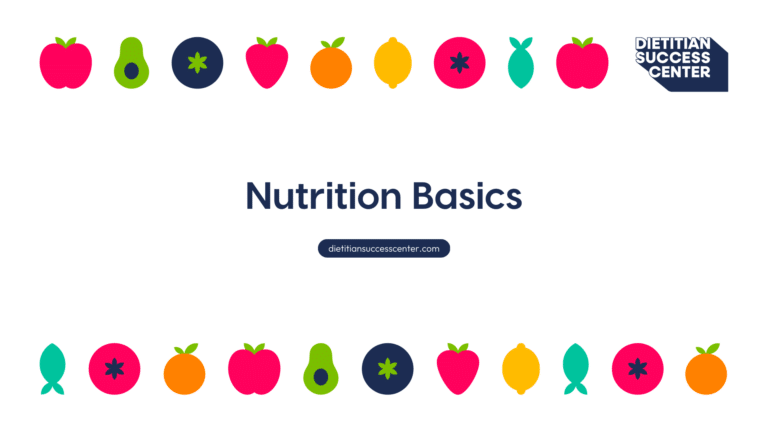![How to Read a Nutrition Label in 5 Simple Steps [Health Canada Nutrition Facts Label]](https://dietitiansuccesscenter.com/wp-content/uploads/2024/05/2-1-1024x576.png)

Written and Presented by Krista Kolodziejzyk, RD, MPH, MBA
Reviewed by Olivia Farrow, RD, MHSc
Nutrition labels, and specifically, the Nutrition Facts Table, can help you compare packaged food and drink products and make the best choices for your nutrition needs.
In this video and blog, we will cover the 5 steps to reading a nutrition facts table, including, where to find key information, which information we want to focus on, and what the % means on the right side of the table.
Quick Links
Step 1 - Serving Size
If you’ve looked at the Nutrition Facts Table before, which value do you tend to look at first? Lots of people will say “Calories” – but, there’s actually a step that goes before this.
This brings us to Step 1 – Check the serving size.
The serving size is the number at the top of the table. The serving size does not tell you the amount you “should” be eating, it is just a standard amount that food companies use.
But, it is important because all the nutrition information that follows in the table is based on this amount – so in this example 1 cup of this food has 110 calories, 0g of fat, 26g of carbohydrates, 2g of protein and so on…
Keep in mind, the serving size listed might be less or more than you will eat. So if you’re going to eat double the serving size, you’ll have to double all the values in the table.
So, for example, if the serving size says “1 cup” but you are going to eat double that amount, 2 cups, you would have to double all of the nutrition values in the table. For example, 110 calories becomes 220 calories. and so on.
Step 2 - Scan the Nutrients
Which brings us to Step 2 – Scan the nutrients found in the table.
As we move down the label, you’ll see “calories” next. Calories act like fuel for your body, similar to how gasoline acts as fuel for a car. So this value tells you how much fuel you get from one serving of the product.
Though calories may be helpful to know about depending on your nutrition goals, we likely want to pay more attention to the information listed below calories – including Fats, Carbohydrates, Protein, Cholesterol, Sodium and vitamins and minerals like Potassium, Calcium and Iron.
Step 3 - % Daily Value
You may be wondering – what is the % listed along the right side of the table? This is the % daily value (%D.V.). This value can tell you if a food is high or low in a specific nutrient.
A good rule of thumb is that:
- 5% or less is “a little”
- 15% or more is “a lot”
Step 4 - Determine Which Nutrients You Want “More” or “Less” of
Though every person has unique nutrition goals, in general, unless you’ve been told otherwise by your healthcare provider, most people will want to choose foods that are higher in fibre, potassium, calcium, and iron. And, In general, most people will want to choose foods that are lower in sodium, added sugars, and saturated fat.
Depending on your nutrition goals, you may be looking for more protein as well. Keep in mind, there is no %DV for protein because according to Health Canada, most Canadians get enough protein in their diet if they’re eating a variety of foods, so it’s not a health concern. But, if you’re looking for more protein, you will have to look at the amount in grams and compare that to your goal amount.
It might feel a little bit overwhelming to focus on all of these nutrients. So instead, pick one or two to focus on based on your nutrition goals. Your dietitian can help you decide which nutrients to pay attention to on the nutrition label.
Fibre helps to keep you fuller for longer, it also helps to keep your digestive system working well.
Potassium helps the body manage blood pressure and is important for nerve and muscle function.
Calcium is necessary for healthy bones and teeth, it’s also important for muscles and heart health
Iron helps move oxygen around your body through the blood.
Sugars can be a little bit confusing. One important thing to note about the nutrition facts table is that it does not always differentiate between added sugars (so, sugars added during the food or drink manufacturing process) and those that are naturally present (or naturally occurring) in a food.
So for example, 1 medium gala apple has about 18g of total sugar. But, obviously, no sugar has been added to this food, this sugar is naturally present, or naturally-occuring.
1 can of regular pop has about 25g of sugar. All of this sugar has been added to the product
Ultimately, these are the types of sugars we want to try and limit – the ones that have been added to a product.
So, how can we tell if sugars have been added or they are naturally present?
The ingredients list can help to tell you whether the sugars are “added” to a product. Ingredients lists are in order of quantity. If sugar is the first ingredient, it is the most plentiful.
Added sugar can go by many different names on the ingredient list. Sugar ingredients often end in -ose. Look for names for sugar like: “dextrose”, “glucose”, “maltose”, “sucrose”. Added sugar also comes from common ingredients like honey, agave, syrup, juice concentrate
Gala apple nutrition = https://food-nutrition.canada.ca/cnf-fce/report-rapport
Step 5 - Compare Foods Based on Your Nutrition Goals
Now that we know where to find information, and which information we want to focus on, we can use this to compare two foods and decide which one is the better choice for us.
Remember, all foods can fit in a healthy diet. Even if a food is higher in sugar, salt or saturated fat, enjoy these foods once in a while, vs. everyday.
Let’s run through an example:
This is a nutrition facts table from a box of cereal, let’s take a look and run through our 5 steps.
Step 1 – check the serving size. For this box of cereal, the serving size is 1 cup or 30g. If you make a fist, that’s about the size of 1 cup. Now, this leads to step 2 – browse the nutrients.
If we eat 1 cup, we will get 120 calories, 0.1g of fat, 27g of carbohydrates, 1g of fibre, 16g of sugar, 1g of protein, and so on. On the right side of the table, you can also see the nutrition facts if you were to eat this cereal with 125mL of 1% milk.
Now, let’s move on to Step 3 – look at the % daily value to determine which nutrients this food has a lot or a little bit of.
As a reminder, 5% or less is “a little” – most people will want to choose foods that are lower in saturated fat, added sugars and sodium. 15% or more is “a lot” – most people will want to choose foods that are higher in fibre, potassium, calcium, and iron.
So, this food has:
- 0% saturated fat
- 16% sugars
- 3% sodium
- 4% fibre
- 1% potassium
- 0% calcium
- 22% iron
Step 4 – determining which nutrients you are aiming for more or less of depending on your nutrition goals. Let’s say that we are looking to increase fibre and reduce added sugar. How do we know if sugar is added to this food?
When we look at the ingredient list, we can see sugar is listed as the second ingredient. This brings us to step 5 where, knowing this information we can compare the food with another one to choose the best option for us.
Let’s compare this food to steel cut oats, for example. For 1/4 cup of dry oats we get:
- 14% fibre
- 0% sugar
And, if we look at the ingredient list, the only ingredient is 100% whole grain oats. So, if I’m looking for an option with less sugar and more fibre, I’m better off choosing the oats and adding some nutritious inclusions like fresh fruit, nut butter or seeds.
Recap
To recap what we’ve learned in this video:
- The nutrition facts table can be a helpful tool to learn about the nutrition in a specific food or drink, it can also be used to help compare two or more items to determine which one you want to choose
- Look at the serving size first. Remember, this is not the recommended amount you ‘should’ eat/drink, it is simply a standard serving size. Adjust the nutritional information based on the amount you would typically have.
- Most people will want to aim for 5% or less D.V. of sodium, sugars and saturated fats.
- Most people will want to aim for 15% or more D.V. of fibre, potassium, calcium and iron.
- Check out the ingredient list to look for sources of added sugars.
- Remember, calories are not the most important information on the nutrition facts table.
- All foods can fit in a healthy diet. Even if a food is higher in sugar, salt or saturated fat, enjoy these foods once in a while, vs. everyday.
Thanks for listening! Found this video or blog helpful? Share it with a friend or colleague.






![[YouTube] For Kids How to Read a Nutrition Label - Canadian](https://dietitiansuccesscenter.com/wp-content/uploads/2024/05/3-2-768x432.png)
